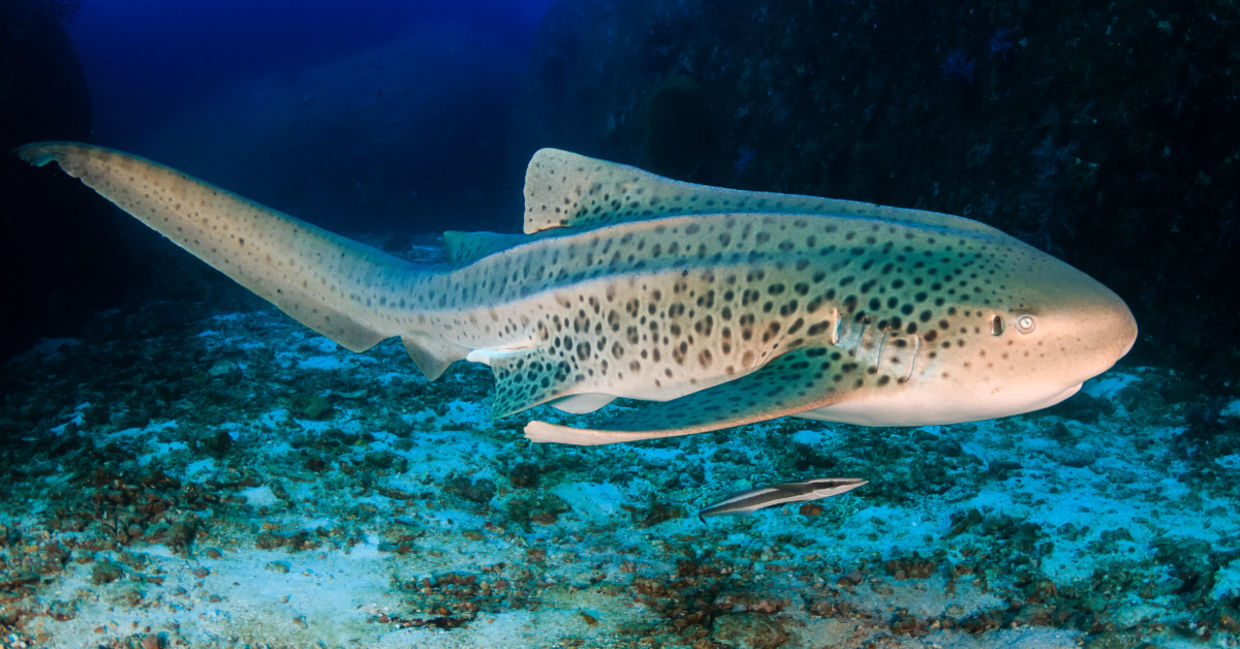
(Richard Whitcombe / Shutterstock.com)
A new international organization comprising partners from 15 countries and 44 aquariums, is challenging the diminishing shark statistics. According to National Geographic, ReShark's goal is to release 500 endangered zebra sharks in Indonesian waters to revive a self-sustaining wild population that is on the brink of extinction.
This is the first-ever attempt to reintroduce captive sharks into the wild, unlike land animals such as California condors and giant pandas in China that have been successfully reintroduced in the past.
“It’s such a milestone,” Nesha Ichida, an Indonesian marine scientist helping manage this work for ReShark, told National Geographic. “This is such a hopeful, momentous moment.”
In the scorching heat of January, Ichida kneeled in a picturesque turquoise lagoon located in Indonesia's Raja Ampat archipelago, tenderly cradling a baby zebra shark named Charlie, the first captive animal to be released into these waters. Charlie was named after a West Papuan provincial official who had championed the project. The shark was adorned with a combination of light stripes and circles that spiraled down its seemingly endless tail.
This 15-week-old zebra shark, similar to its counterparts, develops in an egg, which is also referred to as a mermaid’s purse. This egg was laid at Sea Life Sydney Aquarium in Australia and transported to Indonesia, where it was hatched in a newly established shark nursery.
Although the zebra shark population is thriving in the Pacific Ocean off North Queensland, the species is almost extinct in Raja Ampat, located 1,500 miles northwest, due to the global shark trade. Only three zebra sharks were spotted during 15,000 hours of research conducted between 2001 and 2021.
“I'm feeling very hopeful that Charlie is going to be the ambassador for all shark species,” Ichida told The Daily Mail, as she released Charlie. Raja Ampat was selected due to its globally acclaimed conservation success as Asia's first shark and ray sanctuary.
A history of sharks
Sharks in this location, similar to many other areas, had undergone culling for several decades. As a result, their numbers dwindled and by the 1990s, only a handful were left, according to a research article published in Frontiers in Marine Science. However, in the mid-2000s, the area implemented nine marine protected areas, encompassing approximately 8,000 square miles, an area half the size of Switzerland. Additionally, fishing for sharks and rays was banned across a larger region, and enforcement patrols were deployed to combat illegal fishing nets and boats. By 2012, shark populations had begun to recover, with notable improvements observed in grey, blacktip, and whitetip reef sharks.
Sharks have a remarkable history as one of the oldest vertebrate species, surviving five mass extinctions over a span of 420 million years, according to the organization Shark Trust. However, they are now facing the second-highest rate of disappearance among vertebrates after amphibians. Research conducted by Nick Dulvy, former head of the Shark Specialist Group of the International Union for Conservation of Nature (IUCN), reveals that more than 37 percent of the 1,199 shark and ray species are at risk of extinction due to overfishing, both legal and illegal.
Sharks play a crucial role in marine ecosystems by regulating the ocean's food chains and preventing the overpopulation of smaller creatures that could destroy natural systems that sustain billions of people.
Sharks are hunted for their meat, which is consumed in countries like Brazil, the United States, India, and Iceland. Nearly 100 million sharks are slaughtered by human hands each year, according to the organization Sentient Media. In a 2021 movie that documents the slaughter, Fin chronicles the causes, including overfishing and the rise in popularity of the rare and pricey dish, shark fin soup, eaten mainly in China and Vietnam.
Planning for success
Team ReShark understands that reintroduction can also fail, The Daily Mail reports. Juvenile sharks are prone to disease and predators, and they struggle to find food on their own.
Despite the alarming decline in shark populations globally, top shark scientists are hopeful that ReShark's efforts will succeed, and they are already exploring plans to apply the same approach to other shark species in various parts of the world.
Marine reintroductions pose significant challenges due to the complexity and scarcity of ocean life, as well as the difficulty in managing threats, according to National Geographic. While some groups have released captive sharks back into the wild, these efforts are often limited in scope and may not involve endangered species.
Additionally, without addressing the root cause of overfishing, simply adding more sharks to the ocean will not lead to population-level improvements. David Shiffman, a biologist and author of Why Sharks Matter: A Deep Dive with the World’s Most Misunderstood Predator, told The Daily Mail that "everything is harder when the ocean is involved."
Given these challenges, Simon Fraser University ecologist Dulvy initially had reservations about ReShark's plans. However, after asking tough questions, he was surprised by the initiative's potential. “This initiative is different,” Dulvy explained.
Similarly, Rima Jabado, Dulvy's successor at the IUCN, recognized ReShark as a unique project that could provide a lifeline for endangered shark species. “[It] may provide an opportunity for species not to go extinct,” she said.
YOU MIGHT ALSO LIKE:
Sharks Reveal World’s Largest Seagrass Meadow
Mexico Created the Largest Ocean Reserve in North America
Why Hawaii Is Trying a Bold Plan to Outlaw Killing Sharks







